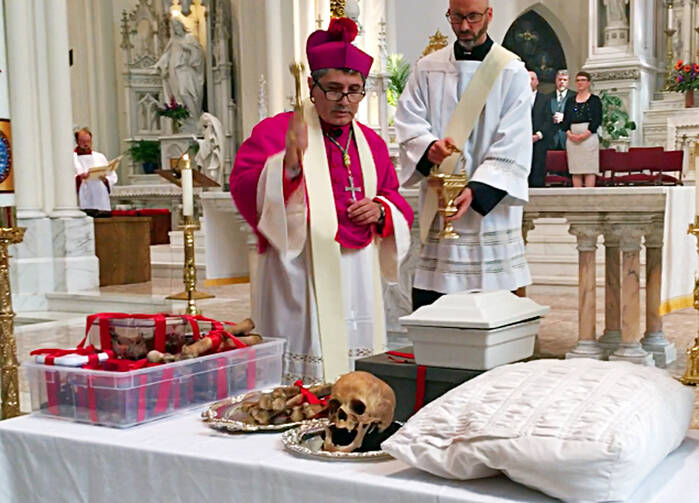In a step toward possible sainthood, the remains of a former slave have been moved to a Catholic cathedral in Denver, where people lined up Wednesday to honor her and pray for her help.
Many touched the glass covering of a wooden chest holding the exhumed skull and other bones of Julia Greeley, a domestic worker known for her charity work and evangelism until her death in 1918.
Others placed rosary beads on top of the chest, snapped photos and held up their children so they could view the sacred remains.
After the viewing, the chest was screwed shut, sealed with gold wax and moved to a prominent spot next to the altar at the Cathedral Basilica of the Immaculate Conception.
The remains were exhumed last month from a grave in a suburban Denver cemetery and moved to the cathedral—a typical step at the beginning of the sainthood process, archdiocesan spokeswoman Karna Swanson said.
Greeley is one of four people that U.S. bishops voted to allow to be investigated for possible sainthood at their fall meeting. She joins four other African Americans placed into consideration in recent years. She is also the first person to be interred in the Denver cathedral since it opened in 1912.
"Not a bishop, not a priest, but a lay woman," Auxiliary Bishop Jorge H. Rodriguez-Novelo noted during the ceremony Wednesday that came 99 years to the day after Greeley died on her way to Mass.
The archdiocese is gathering testimony and documentation about Greeley's life as part of the first stage of the sainthood process. It will send a report to the Vatican, which will then decide whether to investigate Greeley's virtues.
After that, church officials would look at whether any miracles could be attributed to Greeley, who was known for providing wood, coal and other supplies for people in need. She did the work at night to remain anonymous and to avoid embarrassment for those receiving the help.
Greeley sometimes sent children to knock on the doors of those who needed help then run away, said Mary Leisring, president of the Julia Greeley Guild, which helps promote her story.
Greeley was born into slavery in Hannibal, Missouri, sometime between 1833 and 1848. As a child she lost an eye after the slave owner accidentally struck her with a whip while beating her mother.
Greeley routinely visited every fire station in the city to spread her faith because she wanted to make sure the firefighters were prepared to meet God should they die on the job.
She did her charitable work on foot despite suffering from extensive arthritis, which was confirmed by Christine Pink of Metropolitan State University, a forensic anthropologist who supervised the exhumation of her bones.
The initial screening of Greeley by the archdiocese is expected to be completed next year.
"Whether she is an official saint or not she's already a saint to me," Leisring said.
Copyright 2017 The Associated Press. All rights reserved. This material may not be published, broadcast, rewritten or redistributed.











At long last, St. Julia Greeley.